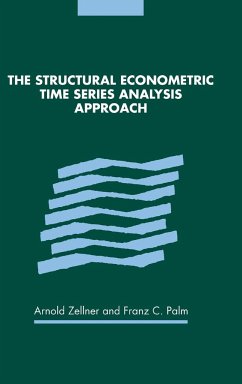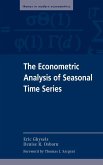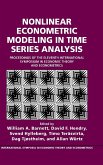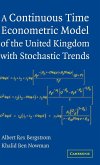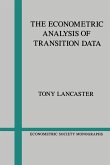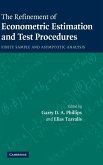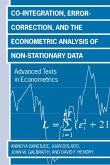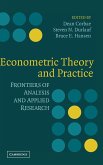Arnold Zellner / Franz C. Palm (eds.)
The Structural Econometric Time Series Analysis Approach
Herausgeber: Zellner, Arnold; Palm, Franz C.
Arnold Zellner / Franz C. Palm (eds.)
The Structural Econometric Time Series Analysis Approach
Herausgeber: Zellner, Arnold; Palm, Franz C.
- Gebundenes Buch
- Merkliste
- Auf die Merkliste
- Bewerten Bewerten
- Teilen
- Produkt teilen
- Produkterinnerung
- Produkterinnerung
This 2004 text offers key texts in the theory and application of the Structural Econometric Time Series Analysis (SEMTSA) approach.
Andere Kunden interessierten sich auch für
![The Econometric Analysis of Seasonal Time Series The Econometric Analysis of Seasonal Time Series]() Eric GhyselsThe Econometric Analysis of Seasonal Time Series114,99 €
Eric GhyselsThe Econometric Analysis of Seasonal Time Series114,99 €![Nonlinear Econometric Modeling in Time Series Nonlinear Econometric Modeling in Time Series]() A. Barnett / F. Hendry / Svend Hylleberg / Timo Teräsvirta / Dag Tjøstheim / Allan Würtz (eds.)Nonlinear Econometric Modeling in Time Series136,99 €
A. Barnett / F. Hendry / Svend Hylleberg / Timo Teräsvirta / Dag Tjøstheim / Allan Würtz (eds.)Nonlinear Econometric Modeling in Time Series136,99 €![A Continuous Time Econometric Model of the United Kingdom with Stochastic Trends A Continuous Time Econometric Model of the United Kingdom with Stochastic Trends]() Albert Rex BergstromA Continuous Time Econometric Model of the United Kingdom with Stochastic Trends119,99 €
Albert Rex BergstromA Continuous Time Econometric Model of the United Kingdom with Stochastic Trends119,99 €![The Econometric Analysis of Transition Data The Econometric Analysis of Transition Data]() Tony LancasterThe Econometric Analysis of Transition Data52,99 €
Tony LancasterThe Econometric Analysis of Transition Data52,99 €![The Refinement of Econometric Estimation and Test Procedures The Refinement of Econometric Estimation and Test Procedures]() Garry D. A. Phillips / Elias Tzavalis (eds.)The Refinement of Econometric Estimation and Test Procedures121,99 €
Garry D. A. Phillips / Elias Tzavalis (eds.)The Refinement of Econometric Estimation and Test Procedures121,99 €![Co-Integration, Error Correction, and the Econometric Analysis of Non-Stationary Data Co-Integration, Error Correction, and the Econometric Analysis of Non-Stationary Data]() Anindya BanerjeeCo-Integration, Error Correction, and the Econometric Analysis of Non-Stationary Data74,99 €
Anindya BanerjeeCo-Integration, Error Correction, and the Econometric Analysis of Non-Stationary Data74,99 €![Econometric Theory and Practice Econometric Theory and Practice]() P. Corbae / N. Durlauf / E. Hansen (eds.)Econometric Theory and Practice64,99 €
P. Corbae / N. Durlauf / E. Hansen (eds.)Econometric Theory and Practice64,99 €-
-
-
This 2004 text offers key texts in the theory and application of the Structural Econometric Time Series Analysis (SEMTSA) approach.
Produktdetails
- Produktdetails
- Verlag: Cambridge University Press
- Seitenzahl: 736
- Erscheinungstermin: 22. Januar 2016
- Englisch
- Abmessung: 235mm x 157mm x 47mm
- Gewicht: 1327g
- ISBN-13: 9780521814072
- ISBN-10: 0521814073
- Artikelnr.: 20951635
- Herstellerkennzeichnung
- Libri GmbH
- Europaallee 1
- 36244 Bad Hersfeld
- gpsr@libri.de
- Verlag: Cambridge University Press
- Seitenzahl: 736
- Erscheinungstermin: 22. Januar 2016
- Englisch
- Abmessung: 235mm x 157mm x 47mm
- Gewicht: 1327g
- ISBN-13: 9780521814072
- ISBN-10: 0521814073
- Artikelnr.: 20951635
- Herstellerkennzeichnung
- Libri GmbH
- Europaallee 1
- 36244 Bad Hersfeld
- gpsr@libri.de
Arnold Zellner is H. G. B. Alexander Distinguished Service Professor Emeritus of Economics and Statistics, Graduate School of Business, University of Chicago and Adjunct Professor, University of California at Berkeley. He has published books and many articles on the theory and application of econometrics and statistics to a wide range of problems.
Franz C. Palm is Professor of Econometrics, Faculty of Economics and Business Administration, Maastricht University. He has published many articles on the theory and application of econometrics and statistics to a wide range of problems.
Franz C. Palm is Professor of Econometrics, Faculty of Economics and Business Administration, Maastricht University. He has published many articles on the theory and application of econometrics and statistics to a wide range of problems.
Introduction; Part I. The SEMTSA Approach: 1. Time series analysis and
simultaneous equation econometric models A. Zellner and F. C. Palm; 2.
Statistical analysis of econometric models A. Zellner; 3. Structural
econometric modeling and time series analysis: an integrated approach F. C.
Palm; 4. Time series analysis, forecasting and econometric modeling: the
structural econometric modeling, times series analysis (SEMTSA) approach A.
Zellner; 5. Large sample estimation and testing procedures for dynamic
equation systems F. Palm and A. Zellner; Part II. Selected Applications: 6.
Time series and structural analysis of monetary models of the US economy A.
Zellner and F. Palm; 7. Time series versus structural models: a case study
of Canadian manufacturing inventory behavior P. K. Trivedi; 8. Time series
analysis of the German hyperinflation P. Evans; 9. A time series analysis
of seasonality in econometric models C. I. Plosser; 10. The behavior of
speculative prices and the consistency of economic models R. I. Webb; 11. A
comparison of the stochastic processes of structural and time series
exchange rate models F. W. Ahking and S. M. Miller; 12. Encompassing
univariate models in multivariate times series: a case study A. Maravall
and A. Mathis; Part III. Macroeconomic Forecasting and Modeling: 13.
Macroeconomic forecasting using pooled international data A. Garcia-Ferrer,
R. A. Highfield, F. Palm and A. Zellner; 14. Forecasting international
growth rates using Bayesian shrinkage and other procedures A. Zellner and
C. Hong; 15. Turning points in economic time series, loss structures and
Bayesian forecasting A. Zellner, C. Hong and G. M. Gulati; 16. Forecasting
turning points in international output growth rates using Bayesian
exponentially weighted autoregression, time-varying parameter and pooling
techniques A. Zellner, C. Hong and C. Min; 17. Bayesian and non-Bayesian
methods for combining models and forecasts with applications to forecasting
international growth rates C. Min and A. Zellner; 18. Pooling in dynamic
panel data models: an application to forecasting GDP growth rates A. J.
Hoogstrate, F. C. Palm and G. A. Pfann; 19. Forecasting turning points in
countries' output growth rates: a response to Milton Friedman A. Zellner
and C. Min; 20. Using Bayesian techniques for data pooling in regional
payroll forecasting J. P. LeSage and M. Magura; 21. Forecasting turning
points in metropolitan employment growth rates using Bayesian techniques J.
P. LeSage; 22. A note on aggregation, disaggregation and forecasting
performance A. Zellner and J. Tobias; 23. The Marshallian macroeconomic
model A. Zellner; 24. Bayesian modeling of economies and data requirements
A. Zellner and B. Chen.
simultaneous equation econometric models A. Zellner and F. C. Palm; 2.
Statistical analysis of econometric models A. Zellner; 3. Structural
econometric modeling and time series analysis: an integrated approach F. C.
Palm; 4. Time series analysis, forecasting and econometric modeling: the
structural econometric modeling, times series analysis (SEMTSA) approach A.
Zellner; 5. Large sample estimation and testing procedures for dynamic
equation systems F. Palm and A. Zellner; Part II. Selected Applications: 6.
Time series and structural analysis of monetary models of the US economy A.
Zellner and F. Palm; 7. Time series versus structural models: a case study
of Canadian manufacturing inventory behavior P. K. Trivedi; 8. Time series
analysis of the German hyperinflation P. Evans; 9. A time series analysis
of seasonality in econometric models C. I. Plosser; 10. The behavior of
speculative prices and the consistency of economic models R. I. Webb; 11. A
comparison of the stochastic processes of structural and time series
exchange rate models F. W. Ahking and S. M. Miller; 12. Encompassing
univariate models in multivariate times series: a case study A. Maravall
and A. Mathis; Part III. Macroeconomic Forecasting and Modeling: 13.
Macroeconomic forecasting using pooled international data A. Garcia-Ferrer,
R. A. Highfield, F. Palm and A. Zellner; 14. Forecasting international
growth rates using Bayesian shrinkage and other procedures A. Zellner and
C. Hong; 15. Turning points in economic time series, loss structures and
Bayesian forecasting A. Zellner, C. Hong and G. M. Gulati; 16. Forecasting
turning points in international output growth rates using Bayesian
exponentially weighted autoregression, time-varying parameter and pooling
techniques A. Zellner, C. Hong and C. Min; 17. Bayesian and non-Bayesian
methods for combining models and forecasts with applications to forecasting
international growth rates C. Min and A. Zellner; 18. Pooling in dynamic
panel data models: an application to forecasting GDP growth rates A. J.
Hoogstrate, F. C. Palm and G. A. Pfann; 19. Forecasting turning points in
countries' output growth rates: a response to Milton Friedman A. Zellner
and C. Min; 20. Using Bayesian techniques for data pooling in regional
payroll forecasting J. P. LeSage and M. Magura; 21. Forecasting turning
points in metropolitan employment growth rates using Bayesian techniques J.
P. LeSage; 22. A note on aggregation, disaggregation and forecasting
performance A. Zellner and J. Tobias; 23. The Marshallian macroeconomic
model A. Zellner; 24. Bayesian modeling of economies and data requirements
A. Zellner and B. Chen.
Introduction; Part I. The SEMTSA Approach: 1. Time series analysis and
simultaneous equation econometric models A. Zellner and F. C. Palm; 2.
Statistical analysis of econometric models A. Zellner; 3. Structural
econometric modeling and time series analysis: an integrated approach F. C.
Palm; 4. Time series analysis, forecasting and econometric modeling: the
structural econometric modeling, times series analysis (SEMTSA) approach A.
Zellner; 5. Large sample estimation and testing procedures for dynamic
equation systems F. Palm and A. Zellner; Part II. Selected Applications: 6.
Time series and structural analysis of monetary models of the US economy A.
Zellner and F. Palm; 7. Time series versus structural models: a case study
of Canadian manufacturing inventory behavior P. K. Trivedi; 8. Time series
analysis of the German hyperinflation P. Evans; 9. A time series analysis
of seasonality in econometric models C. I. Plosser; 10. The behavior of
speculative prices and the consistency of economic models R. I. Webb; 11. A
comparison of the stochastic processes of structural and time series
exchange rate models F. W. Ahking and S. M. Miller; 12. Encompassing
univariate models in multivariate times series: a case study A. Maravall
and A. Mathis; Part III. Macroeconomic Forecasting and Modeling: 13.
Macroeconomic forecasting using pooled international data A. Garcia-Ferrer,
R. A. Highfield, F. Palm and A. Zellner; 14. Forecasting international
growth rates using Bayesian shrinkage and other procedures A. Zellner and
C. Hong; 15. Turning points in economic time series, loss structures and
Bayesian forecasting A. Zellner, C. Hong and G. M. Gulati; 16. Forecasting
turning points in international output growth rates using Bayesian
exponentially weighted autoregression, time-varying parameter and pooling
techniques A. Zellner, C. Hong and C. Min; 17. Bayesian and non-Bayesian
methods for combining models and forecasts with applications to forecasting
international growth rates C. Min and A. Zellner; 18. Pooling in dynamic
panel data models: an application to forecasting GDP growth rates A. J.
Hoogstrate, F. C. Palm and G. A. Pfann; 19. Forecasting turning points in
countries' output growth rates: a response to Milton Friedman A. Zellner
and C. Min; 20. Using Bayesian techniques for data pooling in regional
payroll forecasting J. P. LeSage and M. Magura; 21. Forecasting turning
points in metropolitan employment growth rates using Bayesian techniques J.
P. LeSage; 22. A note on aggregation, disaggregation and forecasting
performance A. Zellner and J. Tobias; 23. The Marshallian macroeconomic
model A. Zellner; 24. Bayesian modeling of economies and data requirements
A. Zellner and B. Chen.
simultaneous equation econometric models A. Zellner and F. C. Palm; 2.
Statistical analysis of econometric models A. Zellner; 3. Structural
econometric modeling and time series analysis: an integrated approach F. C.
Palm; 4. Time series analysis, forecasting and econometric modeling: the
structural econometric modeling, times series analysis (SEMTSA) approach A.
Zellner; 5. Large sample estimation and testing procedures for dynamic
equation systems F. Palm and A. Zellner; Part II. Selected Applications: 6.
Time series and structural analysis of monetary models of the US economy A.
Zellner and F. Palm; 7. Time series versus structural models: a case study
of Canadian manufacturing inventory behavior P. K. Trivedi; 8. Time series
analysis of the German hyperinflation P. Evans; 9. A time series analysis
of seasonality in econometric models C. I. Plosser; 10. The behavior of
speculative prices and the consistency of economic models R. I. Webb; 11. A
comparison of the stochastic processes of structural and time series
exchange rate models F. W. Ahking and S. M. Miller; 12. Encompassing
univariate models in multivariate times series: a case study A. Maravall
and A. Mathis; Part III. Macroeconomic Forecasting and Modeling: 13.
Macroeconomic forecasting using pooled international data A. Garcia-Ferrer,
R. A. Highfield, F. Palm and A. Zellner; 14. Forecasting international
growth rates using Bayesian shrinkage and other procedures A. Zellner and
C. Hong; 15. Turning points in economic time series, loss structures and
Bayesian forecasting A. Zellner, C. Hong and G. M. Gulati; 16. Forecasting
turning points in international output growth rates using Bayesian
exponentially weighted autoregression, time-varying parameter and pooling
techniques A. Zellner, C. Hong and C. Min; 17. Bayesian and non-Bayesian
methods for combining models and forecasts with applications to forecasting
international growth rates C. Min and A. Zellner; 18. Pooling in dynamic
panel data models: an application to forecasting GDP growth rates A. J.
Hoogstrate, F. C. Palm and G. A. Pfann; 19. Forecasting turning points in
countries' output growth rates: a response to Milton Friedman A. Zellner
and C. Min; 20. Using Bayesian techniques for data pooling in regional
payroll forecasting J. P. LeSage and M. Magura; 21. Forecasting turning
points in metropolitan employment growth rates using Bayesian techniques J.
P. LeSage; 22. A note on aggregation, disaggregation and forecasting
performance A. Zellner and J. Tobias; 23. The Marshallian macroeconomic
model A. Zellner; 24. Bayesian modeling of economies and data requirements
A. Zellner and B. Chen.

